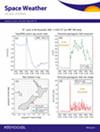基于深度学习的区域电离层总电子含量预测--长短期记忆(LSTM)和卷积 LSTM 方法
IF 3.7
2区 地球科学
引用次数: 0
摘要
本研究评估了深度学习方法在磁静止期间预测电离层总电子含量(TEC)方面的性能。采用两种深度学习技术,即长短期记忆(LSTM)和卷积 LSTM(ConvLSTM),预测朝鲜半岛附近(26.5°-40°N,121°-134.5°E)提前 24 小时的 TEC 值。LSTM 方法根据单点的时间序列数据预测该点的 TEC 值,而 ConvLSTM 方法则利用 TEC 的时空分布同时预测多个点的 TEC 值。LSTM 和 ConvLSTM 模型都是通过对观测到的 TEC 数据应用深度卷积生成对抗网络-泊松混合(DCGAN-PB)方法重建的完整区域 TEC 地图进行训练的。训练时间跨度为 2002 年至 2018 年,并使用 2019 年的数据对模型性能进行了评估。我们的结果表明,ConvLSTM 方法优于 LSTM 方法,与地面实况(DCGAN-PB TEC 地图)相比,它生成的 TEC 地图更可靠,均方根误差更小。这一结果表明,深度学习模型可以通过考虑 TEC 的空间信息来提高特定点的 TEC 预测精度。我们得出结论,ConvLSTM 是一种可靠、高效的电离层及时预测方法。本文章由计算机程序翻译,如有差异,请以英文原文为准。
Deep Learning-Based Regional Ionospheric Total Electron Content Prediction—Long Short-Term Memory (LSTM) and Convolutional LSTM Approach
This study evaluates the performance of deep learning approach in the prediction of the ionospheric total electron content (TEC) during magnetically quiet periods. Two deep learning techniques, long short-term memory (LSTM) and convolutional LSTM (ConvLSTM), are employed to predict TEC values 24 hr ahead in the vicinity of the Korean Peninsula (26.5°–40°N, 121°–134.5°E). The LSTM method predicts TEC at a single point based on time series of data at that point, whereas the ConvLSTM method simultaneously predicts TEC values at multiple points using spatiotemporal distribution of TEC. Both the LSTM and ConvLSTM models are trained using the complete regional TEC maps reconstructed by applying the Deep Convolutional Generative Adversarial Network–Poisson Blending (DCGAN-PB) method to observed TEC data. The training period spans from 2002 to 2018, and the model performance is evaluated using 2019 data. Our results show that the ConvLSTM method outperforms the LSTM method, generating more reliable TEC maps with smaller root mean square errors when compared to the ground truth (DCGAN-PB TEC maps). This outcome indicates that deep learning models can improve the prediction accuracy of TEC at a specific point by taking into account spatial information of TEC. We conclude that ConvLSTM is a reliable and efficient approach for the prompt ionospheric prediction.
求助全文
通过发布文献求助,成功后即可免费获取论文全文。
去求助

 求助内容:
求助内容: 应助结果提醒方式:
应助结果提醒方式:


